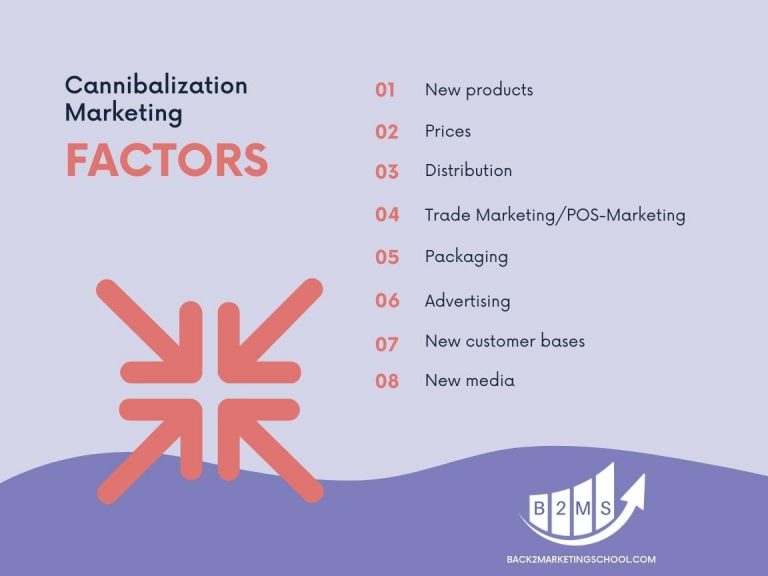Cannibalization Marketing Effect Examples
What is the cannibalization marketing effect?
The cannibalization effect in marketing refers to a negative spillover effect when promoting one product or service to another. The promoted product cannibalizes an existing one with negative effects.
A new edition of a book will result in fewer purchases of the original edition. Another example might be a beverage company launching a sugar-free version. As marketing increases, new target groups will certainly be reached. However, some consumers of the original variant will also switch to the new one.
As already indicated in the examples, a frequent factor in the marketing cannibalization effect is product development. Both in the development of the beverage and of a new book edition, a product has been further developed causing fewer sales of the established product.
However, cannibalization marketing can occur not only in product development but also in all other growth strategies of the market-product grid: Market penetration, market development, product development, and diversification.

Factors influencing the cannibalization marketing effect
There are several factors that can influence the cannibalization effect. In addition to product development that (at least partially) displaces an existing product, other areas can have an influence:
- Prices: Prices not only have a direct influence on the product but can also change brand perception. For example, if a product is heavily discounted, this may create high demand for that product but reduce demand for another of the company’s products.
- Distribution: If one product is distributed through an online retailer but others are not, sales may decline as people prefer to buy through that channel or not at all (or competing products).
- Trade marketing/Point-of-sale marketing: If one product is better placed on brick and mortar shelves than another, this may have a negative impact on other store sales.
- Packaging: Even the packaging of one product can have an influence on another. An existing appearance is no longer found attractive.
- Advertising: Too frequent or “bad” advertising of a product can have a negative impact on the entire brand. Especially in the age of online marketing.
- New customer base: As new markets are developed, existing ones can become disengaged from the products. For example, a textile manufacturer may get a completely different brand image from new target groups that existing customers do not want to identify with.
- New media: A print publisher markets subscriptions to their online media. Some current print subscribers will switch to the new media.
Badge engineering
A special case of the cannibalization effect is the so-called badge engineering. This occurs when a company or group sells very similar products under different names or brands at different prices.
Badge engineering is best explained using an automobile manufacturer as an example. It is not uncommon for car manufacturers to have several brands under one corporate umbrella. Synergies are often exploited and very similar vehicles are sold under different brands. For example, Volkswagen sells the VW Passart at high prices, but the Skoda Octavia at low prices.
Cannibalization marketing in search engine optimization
The cannibalization effect in marketing is sometimes associated with SEO keyword cannibalization.
Keyword cannibalism occurs when several pages of a website are optimized for the same keyword – intentionally or unintentionally. These pages then compete with each other and confuse search engines like Google, so that all afflicted pages are negatively impacted.
Why marketers put up with the cannibalization effect
Despite negative influences, cannibalization effects can sometimes be positive. In the case of product development, this is clear. People buy a new model instead of an old one. But in other Ansoff’s growth strategies, it can make sense to accept negative effects if the positives outweigh the negatives. For example, rebranding may displace an existing target group, but developing new ones may be more lucrative in the long run by increasing overall market share.
Another positive outcome could be that through new channels the costs decrease and therefore the profit margin goes up. Additionally, cross- and up-selling might be easier. Let me explain this with the print-publisher turned digital media outlet: While some print customers switch over to the online subscription, the costs decrease, too. Printing a magazine has higher fixed costs compared to digital publishing. More, having the audience engaged on the website may increase online sales of other products. Therefore cannibalizing the older products will have a positive impact on the bottom line of the business.
How to avoid corporate cannibalism
Cannibalization marketing can’t always be avoided. Especially with new products launching older models will be cannibalized by new product lines. Steve Jobs iPhones are designed to upgrade existing smartphones and only turn to the newer generations of tech.
But what if marketing cannibalization is not intended? The number one task every marketer needs to do before launching a campaign that could have negative spillover effects, is market research. Research how your existing customer base would react to new marketing messaging or channels?
Analyze the risk before: Will lost sales and the cannibalization rate be compensated by the realistic goals of a marketing campaign?

Sascha is a Lifecycle Marketing Consultant with over 8 years of digital marketing experiences in Silicon Valley, the UK, and Germany.
After leading the demand generation for a 100+ million company, he decided to venture out on himself. He’s now helping clients to attract and convert more leads and customers.
His main focus are SEO, paid media & marketing automation – all with the focus to tie marketing campaigns to revenue.
Sascha has been featured in industry publications.



